Form 8-K Zynerba Pharmaceuticals, For: May 16
Exhibit 99.1

Zynerba Pharmaceuticals Reports First Quarter 2022 Financial Results
and Operational Highlights
– Enrollment continues in RECONNECT, a confirmatory pivotal Phase 3 trial of Zygel™ in patients with Fragile X syndrome (FXS); topline results expected second-half 2023 –
– Topline results from Phase 2 trial of Zygel in patients with 22q11.2 deletion syndrome (22q) expected mid-year 2022 –
– $69.7 million in cash and cash equivalents at March 31, 2022; Cash runway into second-half 2023 –
DEVON, Pa., May 16, 2022 – Zynerba Pharmaceuticals, Inc. (Nasdaq: ZYNE), the leader in innovative pharmaceutically-produced transdermal cannabinoid therapies for rare and near-rare neuropsychiatric disorders, today reported financial results for the first quarter ended March 31, 2022, and provided an overview of recent operational highlights and a pipeline update.
“We are excited by the opportunities ahead for Zygel in FXS and other rare and near-rare neuropsychiatric indications, and have made meaningful progress since the beginning of this year,” said Armando Anido, Chairman and Chief Executive Officer of Zynerba. “Specifically, during the first quarter of 2022, we continued to enroll patients in our Phase 3 pivotal trial in patients with FXS, completed enrollment in our Phase 2 trial in patients with 22q11.2 deletion syndrome and advanced toward submission of an Investigational New Drug application for a Phase 3 trial in patients with ASD that we expect to initiate in the second half of 2022.”
Operational Highlights and Pipeline Update
Zygel in Fragile X Syndrome (FXS)
| § | The Company continues to expect topline results from RECONNECT, a confirmatory pivotal Phase 3 trial of Zygel in patients with FXS, in the second half of 2023. The Company believes that the results from RECONNECT, if positive, will be sufficient to support the submission of a New Drug Application (NDA) for Zygel in patients with FXS. |
| § | During the first quarter of 2022, Zynerba received orphan drug designation for cannabidiol, the active ingredient in Zygel, for the treatment of FXS from the European Commission. As previously announced, the Company believes, based on the scientific advice of the European Medicines Agency, that the successful completion of the current development program for Zygel in FXS will satisfy the requirements of a marketing authorization application in the European Union. |
1

| § | Presented data at the 2022 Society of Biological Psychiatry (SOBP) Annual Meeting in April and the 2022 International Society for Autism Research (INSAR) Annual Meeting in May demonstrating that in the long-term safety and efficacy study of Zygel in children and adolescents with FXS, improvement was seen in Social Avoidance in the full population, with the greatest improvement in patients with complete methylation of the FMR1 gene. Patients with complete methylation, who match the primary efficacy population in the ongoing confirmatory trial, RECONNECT, achieved and maintained meaningful change in Social Avoidance, supporting design enhancements for RECONNECT. (Poster and Presentation) |
Zygel in 22q11.2 Deletion Syndrome (22q)
| § | In the first quarter of 2022, the Company completed enrollment for the 14-week open-label Phase 2 INSPIRE trial in children and adolescents with genetically confirmed 22q. The Company continues to expect topline data from INSPIRE mid-year 2022. A total of 20 patients have been enrolled in the INSPIRE trial. |
| § | The Company plans to move forward in 22q as an orphan indication pending results from the INSPIRE trial, and subsequent discussion with the U.S. Food and Drug Administration (FDA) on the regulatory path forward. The Company has previously received orphan drug designation from the FDA for cannabidiol, the active ingredient in Zygel, for the treatment of 22q. |
Zygel in Autism Spectrum Disorder (ASD)
| § | The Company is finalizing the Phase 3 study protocol and will submit an Investigational New Drug application to the FDA prior to commencing the pivotal program. The Company expects to initiate the first of two Phase 3 trials in patients with ASD in the second half of 2022. |
| § | As previously announced, earlier discussions with the FDA included agreement on utilizing the irritability subscale of the Aberrant Behavior Checklist – Community (ABC-C) as the primary endpoint to support an indication for the treatment of irritability in ASD. This is the same primary endpoint utilized in the pivotal trials for the two existing FDA approved treatments for ASD. |
2

First Quarter 2022 Financial Results
Research and development expenses were $5.1 million for the first quarter of 2022, including stock-based compensation of $0.5 million. General and administrative expenses were $3.8 million in the first quarter of 2022, including stock-based compensation expense of $0.6 million. Net loss for the first quarter of 2022 was $8.5 million, with basic and diluted loss per share of $(0.21).
Financial Outlook
As of March 31, 2022, cash and cash equivalents were $69.7 million, compared to $67.8 million as of December 31, 2021. On May 11, 2021, the Company entered into a Controlled Equity OfferingSM Sales Agreement, or the 2021 Sales Agreement”, with Cantor Fitzgerald & Co., Canaccord Genuity, LLC, H.C. Wainwright & Co. LLC and Ladenburg Thalmann & Co. Inc., as sales agents, pursuant to which the Company may sell, from time to time, up to $75.0 million of its common stock. In the first quarter of 2022, the Company sold and issued 857,060 shares of its common stock under the 2021 Sales Agreement in the open market resulting in gross proceeds of $1.8 million and net proceeds of $1.6 million, after deducting commissions and offering expenses. From April 1, 2022 through May 13, 2022, the Company sold and issued 297,362 shares of its common stock under the 2021 Sales Agreement in the open market resulting in gross proceeds and net proceeds of $0.6 million, after deducting commissions and offering expenses.
During the three months ended March 31, 2022, the Company received a payment of $8.0 million from the Australian Tax Office for research and development incentives for the years ended December 31, 2018, 2019 and 2020.
Management believes that the Company’s cash and cash equivalents are sufficient to fund operations and capital requirements into the second half of 2023.
3

About Zygel
Zygel is the first and only pharmaceutically-manufactured cannabidiol formulated as a patent-protected permeation-enhanced clear gel, designed to provide controlled drug delivery into the bloodstream transdermally (i.e. through the skin). Recent studies suggest that cannabidiol may modulate the endocannabinoid system and improve certain behavioral symptoms associated with neuropsychiatric conditions. Zygel is an investigational drug product in development for the potential treatment of behavioral symptoms associated with Fragile X syndrome (FXS), autism spectrum disorder (ASD), and 22q11.2 deletion syndrome (22q). The Company has received orphan drug designation for cannabidiol, the active ingredient in Zygel, from the FDA and the European Commission in the treatment of FXS and by the FDA for the treatment of 22q. Additionally, Zygel has been designated a Fast Track development program for treatment of behavioral symptoms of FXS.
About Zynerba Pharmaceuticals, Inc.
Zynerba Pharmaceuticals is the leader in innovative pharmaceutically-produced transdermal cannabinoid therapies for rare and near-rare neuropsychiatric disorders. We are committed to improving the lives of patients and their families living with severe, chronic health conditions including Fragile X syndrome, autism spectrum disorder, and 22q11.2 deletion syndrome. Learn more at www.zynerba.com and follow us on Twitter at @ZynerbaPharma.
4

Cautionary Note on Forward-Looking Statements
This press release contains forward-looking statements within the meaning of The Private Securities Litigation Reform Act of 1995. We may, in some cases, use terms such as “predicts,” “believes,” “potential,” “proposed,” “continue,” “estimates,” “anticipates,” “expects,” “plans,” “intends,” “may,” “could,” “might,” “will,” “should” or other words that convey uncertainty of future events or outcomes to identify these forward-looking statements. Such statements are subject to numerous important factors, risks and uncertainties that may cause actual events or results to differ materially from the Company’s current expectations. Management’s expectations and, therefore, any forward-looking statements in this press release could also be affected by risks and uncertainties relating to a number of other factors, including the following: the Company’s cash and cash equivalents may not be sufficient to support its operating plan for as long as anticipated; the Company’s expectations, projections and estimates regarding expenses, future revenue, capital requirements, incentive and other tax credit eligibility, collectability and timing, and availability of and the need for additional financing; the Company’s ability to obtain additional funding to support its clinical development programs; the results, cost and timing of the Company’s clinical development programs, including any delays to such clinical trials relating to enrollment or site initiation; clinical results for the Company’s product candidates may not be replicated or continue to occur in additional trials and may not otherwise support further development in a specified indication or at all; actions or advice of the U.S. Food and Drug Administration and foreign regulatory agencies may affect the design, initiation, timing, continuation and/or progress of clinical trials or result in the need for additional clinical trials; the Company’s ability to obtain and maintain regulatory approval for its product candidates, and the labeling under any such approval; the Company’s reliance on third parties to assist in conducting pre-clinical and clinical trials for its product candidates; delays, interruptions or failures in the manufacture and supply of the Company’s product candidates the Company’s ability to commercialize its product candidates; the size and growth potential of the markets for the Company’s product candidates, and the Company’s ability to service those markets; the Company’s ability to develop sales and marketing capabilities, whether alone or with potential future collaborators; the rate and degree of market acceptance of the Company’s product candidates; the Company’s expectations regarding its ability to obtain and adequately maintain sufficient intellectual property protection for its product candidates; and the extent to which health epidemics and other outbreaks of communicable diseases, including COVID-19, could disrupt our operations or adversely affect our business and financial conditions. This list is not exhaustive and these and other risks are described in the Company’s periodic reports, including the annual report on Form 10-K, quarterly reports on Form 10-Q and current reports on Form 8-K, filed with or furnished to the Securities and Exchange Commission and available at www.sec.gov. Any forward-looking statements that the Company makes in this press release speak only as of the date of this press release. The Company assumes no obligation to update forward-looking statements whether as a result of new information, future events or otherwise, after the date of this press release.
5

ZYNERBA PHARMACEUTICALS, INC.
CONSOLIDATED STATEMENTS OF OPERATIONS
| (unaudited) | ||||||||
| Three months ended March 31, | ||||||||
| 2022 | 2021 | |||||||
| Operating expenses: | ||||||||
| Research and development | $ | 5,146,605 | $ | 4,609,010 | ||||
| General and administrative | 3,757,310 | 3,275,797 | ||||||
| Total operating expenses | 8,903,915 | 7,884,807 | ||||||
| Loss from operations | (8,903,915 | ) | (7,884,807 | ) | ||||
| Other income (expense): | ||||||||
| Interest income | 96,044 | 5,633 | ||||||
| Foreign exchange gain (loss) | 317,252 | (82,454 | ) | |||||
| Total other income (expense) | 413,296 | (76,821 | ) | |||||
| Net loss | $ | (8,490,619 | ) | $ | (7,961,628 | ) | ||
| Net loss per share - basic and diluted | $ | (0.21 | ) | $ | (0.20 | ) | ||
| Basic and diluted weighted average shares outstanding | 40,304,484 | 40,065,715 | ||||||
| Non-cash stock-based compensation included above: | ||||||||
| Research and development | $ | 529,496 | $ | 619,391 | ||||
| General and administrative | 630,986 | 645,446 | ||||||
| Total | $ | 1,160,482 | $ | 1,264,837 | ||||
6

ZYNERBA PHARMACEUTICALS, INC.
CONSOLIDATED BALANCE SHEETS
| (unaudited) | ||||||||
| March 31, 2022 | December 31, 2021 | |||||||
| Assets | ||||||||
| Current assets: | ||||||||
| Cash and cash equivalents | $ | 69,697,865 | $ | 67,808,000 | ||||
| Incentive and tax receivables | 1,602,831 | 9,580,468 | ||||||
| Prepaid expenses and other current assets | 1,930,380 | 2,831,392 | ||||||
| Total current assets | 73,231,076 | 80,219,860 | ||||||
| Property and equipment, net | 376,745 | 385,833 | ||||||
| Incentive and tax receivables | 264,206 | — | ||||||
| Right-of-use assets | 509,002 | 565,814 | ||||||
| Total assets | $ | 74,381,029 | $ | 81,171,507 | ||||
| Liabilities and Stockholders' Equity | ||||||||
| Current liabilities: | ||||||||
| Accounts payable | $ | 1,603,834 | $ | 1,798,813 | ||||
| Accrued expenses | 7,103,959 | 7,896,598 | ||||||
| Lease liabilities | 210,512 | 209,068 | ||||||
| Total current liabilities | 8,918,305 | 9,904,479 | ||||||
| Lease liabilities, long-term | 295,754 | 353,694 | ||||||
| Total liabilities | 9,214,059 | 10,258,173 | ||||||
| Stockholders' equity: | ||||||||
| Common stock | 43,324 | 41,218 | ||||||
| Additional paid-in capital | 313,095,744 | 310,353,595 | ||||||
| Accumulated deficit | (247,972,098 | ) | (239,481,479 | ) | ||||
| Total stockholders' equity | 65,166,970 | 70,913,334 | ||||||
| Total liabilities and stockholders' equity | $ | 74,381,029 | $ | 81,171,507 | ||||
7

Zynerba Contacts
Jim Fickenscher, CFO and VP Corporate Development
Zynerba Pharmaceuticals
484.581.7483
Peter Vozzo
ICR Westwicke
Office: 443.213.0505
Cell: 443.377.4767
8
Exhibit 99.2

Corporate Overview May 2022

Forward - Looking Statements 2 © 2022 Zynerba Pharmaceuticals, Inc. All rights reserved. Zynerba and Zygel are trademarks of Zynerba Pharmaceuticals, Inc. All other trademarks and registered trademarks are property of their respective owners. trademarks are property of their respective owners. THE STATEMENTS IN THIS PRESENTATION MAY INCLUDE FORWARD - LOOKING STATEMENTS WITHIN THE MEANING OF THE PRIVATE SECURITIES LITIGATION REFORM ACT OF 1995. THESE STATEMENTS, AMONG OTHER THINGS RELATE TO THE FUTURE OPERATIONS, OPPORTUNITIES OR FINANCIAL PERFORMANCE OF ZYNERBA PHARMACEUTICALS, INC. WE MAY, IN SOME CASES, USE TERMS SUCH AS “PREDICTS,” “BELIEVES,” “POTENTIAL,” “PROPOSED,” “CONTINUE,” “ESTIMATES,” “ANTICIPATES,” “EXPECTS,” “PLANS,” “INTENDS,” “MAY,” “COULD,” “MIGHT,” “WILL,” “SHOULD” OR OTHER WORDS THAT CONVEY UNCERTAINTY OF FUTURE EVENTS OR OUTCOMES TO IDENTIFY THESE FORWARD - LOOKING STATEMENTS. SUCH STATEMENTS ARE SUBJECT TO NUMEROUS IMPORTANT FACTORS, RISKS AND UNCERTAINTIES THAT MAY CAUSE ACTUAL EVENTS OR RESULTS TO DIFFER MATERIALLY FROM THE COMPANY’S CURRENT EXPECTATIONS, INCLUDING THE FOLLOWING: THE COMPANY’S CASH AND CASH EQUIVALENTS MAY NOT BE SUFFICIENT TO SUPPORT ITS OPERATING PLAN FOR AS LONG AS ANTICIPATED; THE RESULTS, COST AND TIMING OF THE COMPANY’S CLINICAL DEVELOPMENT PROGRAMS, INCLUDING ANY DELAYS TO SUCH CLINICAL TRIALS RELATING TO ENROLLMENT OR SITE INITIATION; CLINICAL RESULTS FOR THE COMPANY’S PRODUCT CANDIDATES MAY NOT BE REPLICATED OR CONTINUE TO OCCUR IN THE COMPANY’S ONGOING OR PLANNED CLINICAL TRIALS IN FXS, ASD OR 22Q, OR IN ANY ADDITIONAL TRIALS, AND MAY NOT OTHERWISE SUPPORT FURTHER DEVELOPMENT IN A SPECIFIED INDICATION OR AT ALL; THE COMPANY’S PLANNED RECONNECT TRIAL MAY NOT BE DETERMINED TO BE SUFFICIENT TO SUPPORT A SUBMISSION FOR REGULATORY APPROVAL, INCLUDING AN NDA OR MAA; ACTIONS OR ADVICE OF THE U.S. FOOD AND DRUG ADMINISTRATION AND FOREIGN REGULATORY AGENCIES MAY AFFECT THE DESIGN, INITIATION, TIMING, CONTINUATION AND/OR PROGRESS OF CLINICAL TRIALS OR RESULT IN THE NEED FOR ADDITIONAL CLINICAL TRIALS; THE COMPANY’S ABILITY TO OBTAIN AND MAINTAIN REGULATORY APPROVAL FOR ITS PRODUCT CANDIDATES, AND THE LABELING UNDER ANY SUCH APPROVAL; THE COMPANY’S EXPECTATIONS REGARDING ITS ABILITY TO OBTAIN AND ADEQUATELY MAINTAIN SUFFICIENT INTELLECTUAL PROPERTY PROTECTION FOR ITS PRODUCT CANDIDATES. THESE AND OTHER RISKS ARE DESCRIBED IN OUR FILINGS WITH THE SECURITIES AND EXCHANGE COMMISSION, AVAILABLE AT WWW.SEC.GOV. ANY FORWARD - LOOKING STATEMENTS THAT THE COMPANY MAKES IN THIS PRESENTATION SPEAK ONLY AS OF THE DATE OF THIS PRESENTATION. THE COMPANY ASSUMES NO OBLIGATION TO UPDATE FORWARD - LOOKING STATEMENTS WHETHER AS A RESULT OF NEW INFORMATION, FUTURE EVENTS OR OTHERWISE, AFTER THE DATE OF THIS PRESENTATION .

Zynerba Pharmaceuticals (NASDAQ: ZYNE) 3 A Rare/Near - Rare Neuropsychiatric Company • Deep pipeline targeting high unmet medical needs; translating into multi - billion dollar market opportunity with Zygel Ʀ (Cannabidiol Gel) • Two Phase 3 clinical development programs ongoing/planned • Confirmatory RECONNECT pivotal trial in Fragile X syndrome (FXS) initiated September 2021, with topline results expected 2H 2023 • Plan to initiate pivotal Phase 3 program in autism spectrum disorder (ASD) 2H 2022 • Phase 2 study in 22q11.2 deletion syndrome (22q) fully enrolled, with topline results expected mid - year 2022 • Experienced team with development and commercial expertise in transdermal delivery, orphan diseases, neurology, and psychiatry • Cash runway expected to be sufficient to fund operations and capital requirements into 2H 2023

Deep Clinical Pipeline & Near - term Milestones 4 Zygel Cannabidiol Gel *U.S. Orphan Drug and Fast Track designations; EU Orphan Drug designation **U.S. Orphan Drug designation Expected Milestones Topline results expected 2H 2023 Initiate Phase 3 program 2H 2022 Topline results expected mid - year 2022 Indication Preclinical Phase 1 Phase 2 Fragile X Syndrome (FXS)* Pivotal BRIGHT: Topline data released Autism Spectrum Disorder (ASD) INSPIRE: Enrollment complete RECONNECT: Pivotal confirmatory trial initiated 22q Deletion Syndrome (22q)**

Neuropsych Indications Differentiated Formulation delivers Cannabidiol through the epidermis and into the circulatory system Zygel (ZYN002) Cannabidiol Gel 5 Unique Mechanism of Action First & only patent - protected (2038), permeation - enhanced, pharmaceutically - produced cannabidiol gel Transdermal Cannabidiol modulates multiple receptors and mediates numerous pathways, including the endocannabinoid pathway Potential utility in rare / near - rare neuropsychiatric conditions

6 • Rare genetic developmental disability • Leading known cause of both inherited intellectual disability and ASD • No approved drugs indicated for FXS • Symptoms linked to deficiencies in the endocannabinoid system (ECS) • Mutation impacts FMR1 gene and causes ECS dysregulation, causing core cognitive, social, and behavioral symptoms of FXS • Easily identified mutation manifests as multiple CGG repeats in FMR1 (full mutation = >200 repeats) • U.S. patents provide IP protection to 2038 • FMR1 gene codes for production of FMRP* which is vital to synapse development • Methylation of FMR1 also plays a role in determining functionality of the gene • When methylation of FMR1 silences the gene, no FMRP is produced: Systems and processes affected by FMRP become dysregulated • ~60% of patients are believed to fall into the completely methylated category Fragile X Syndrome (FXS) *FMR Protein; RNA - binding protein that helps regulate synaptic development and plasticity Role of FMR1 Methylation FXS FXS is routinely diagnosed by assessing (1) CGG repeats and (2) methylation status ~47K U.S. patients and ~73K EU/UK patients with complete methylation ~78K U.S. patients and ~121K EU/UK patients with full mutation FXS

CONNECT - FX Trial Design 7 C linical study O f Ca NN abidiol in Childr E n and Adoles C en T s with F ragile X (CONNECT - FX) Zygel (n=110; 72 *) 250 mg daily 500 mg daily (weight - based dose) Placebo (n=102; 65 *) Mirrored Zygel administration 14 weeks Three through 17 years of age Open label extension (OLE) DBPC: Complete 48 months: Ongoing Patients randomized (1:1) to receive either Zygel or placebo * Patients with complete methylation of their FMR1 gene (137 total ~ 65% of trial population)

8 8 CONNECT - FX Results: Complete FMR1 Methylation Consistent Improvements Observed with Zygel vs. Placebo Caregiver reported behavioral change Clinician reported improvements in behavior Clinically meaningful improvements in behavior Primary endpoint Caregiver Global Impression of Change Any Improvement Zygel vs placebo Social interaction 63% vs 37% ( p =0.005*) Irritable/Disruptive Behaviors 54% vs 33% ( p =0.027*) Social Avoidance/Isolation 58% vs 46% ( p =0.195) Overall behavior 61% vs 46% ( p =0.100) Clinically meaningful improvement on drug Significantly more pts achieved a clinically meaningful change Zygel vs placebo Social Avoidance (≥ 3 points) 56% vs 37% ( p =0.030*) Irritability (≥ 9 points) 37% vs 26% ( p =0.232) Clinical Global Impression of Improvement (anchored)** Any Improvement Zygel vs placebo 50% vs 36% ( p =0.128) ABC - C FXS Social Avoidance subscale 40% median percent improvement in socially avoidant behaviors ( p =0.027*) * Statistically significant ** Not specific to Social Avoidance Ad hoc analysis of 136 patients with complete methylation in efficacy population

CONNECT - FX: Safety 9 • Zygel was very well tolerated • No serious or severe adverse events reported during the trial • All treatment - emergent adverse events (TEAEs; any event, whether unrelated or related to study drug) were mild or moderate • Most common treatment - related TEAE: application site pain • Zygel: 6.4%; placebo: 1.0% • Seven total psychiatric disorder TEAEs; 5 were in placebo group • Laboratory values for chemistry and hematology comparable between placebo and Zygel groups; no clinically relevant abnormalities in either group • No clinically significant changes to liver function tests
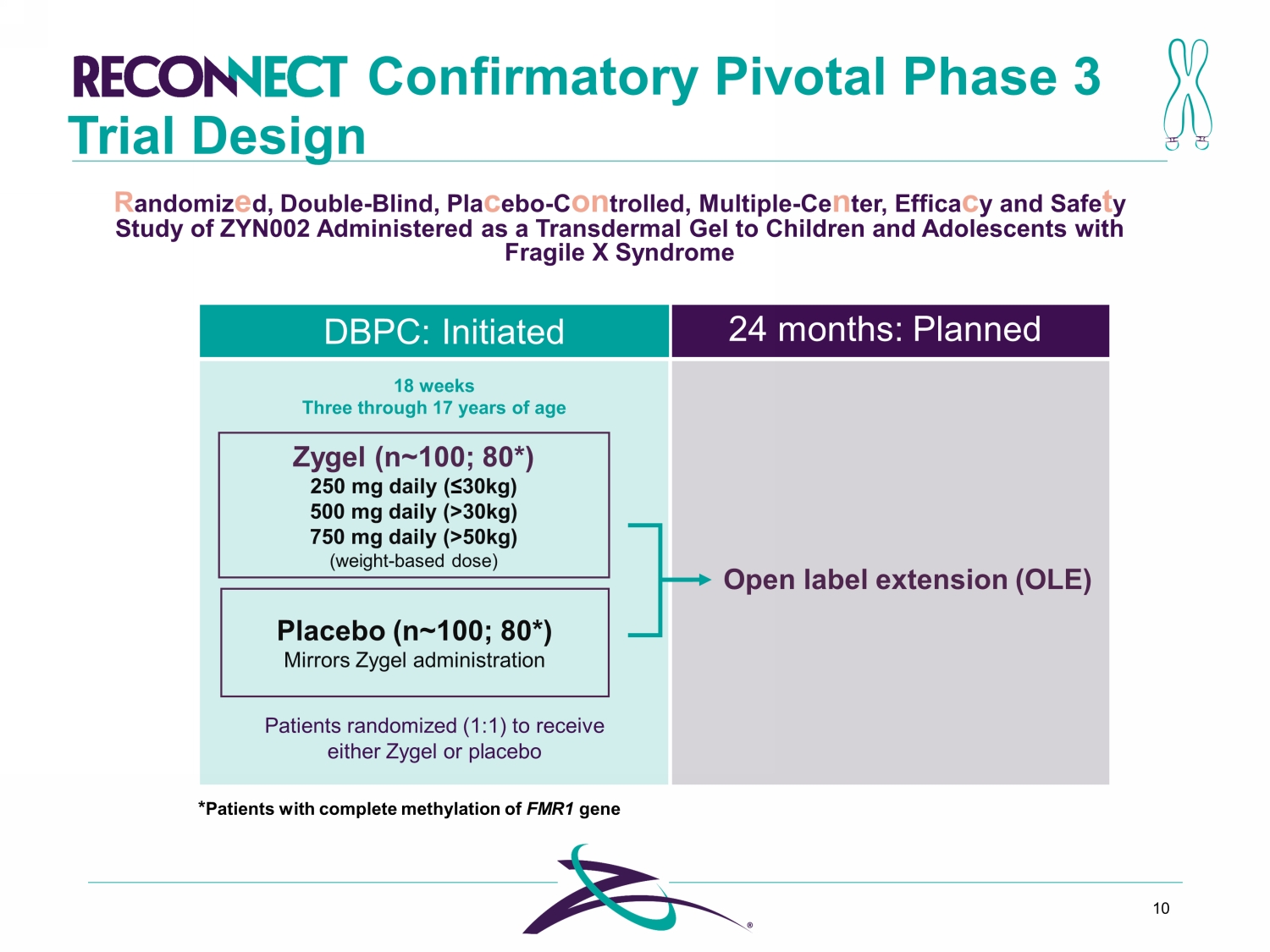
Confirmatory Pivotal Phase 3 10 R andomiz e d, Double - Blind, Pla c ebo - C on trolled, Multiple - Ce n ter, Effica c y and Safe t y Study of ZYN002 Administered as a Transdermal Gel to Children and Adolescents with Fragile X Syndrome Zygel ( n~100 ; 80*) 250 mg daily ( ≤ 30kg) 500 mg daily (> 30kg ) 750 mg daily (> 50kg ) (weight - based dose) Placebo ( n~100 ; 80*) Mirrors Zygel administration 18 weeks Three through 17 years of age Open label extension (OLE) DBPC: Initiated 24 months: Planned Patients randomized (1:1) to receive either Zygel or placebo * Patients with complete methylation of FMR1 gene Trial Design

Primary endpoint • Change from baseline to end of treatment in ABC - C FXS Social Avoidance subscale in patients who have complete (100%) methylation of the FMR1 gene Secondary endpoints • Change from baseline to end of treatment in: • ABC - C FXS Irritability subscale in patients who have complete methylation • ABC - C FXS Social Avoidance subscale among all randomized patients (complete and partial methylation) • Percent of patients: • Any improvement on the Caregiver Global Impression of Change ( CaGI - C) for Social Interactions among patients with complete methylation • Rated as improved on the Clinical Global Impression - Improvement (CGI - I) scale among patients with complete methylation 11 Trial Design

Key study design elements • 18 week trial design will allow us to evaluate improvement in behavioral symptoms over time • Added a third dosing group of 750 mg for individuals >50 kg to maintain appropriate dosing levels for patients • Made trial more patient and family friendly than CONNECT – FX trial – virtual visits, fewer assessments administered, reduced frequency of lab and ECG tests, provided each family an electronic tablet for recording of assessments and skin diaries • Successful completion of current development program for Zygel in FXS expected to satisfy requirements of submitting a New Drug Application in the U.S. and a marketing authorization application in European Union 12 Trial Design
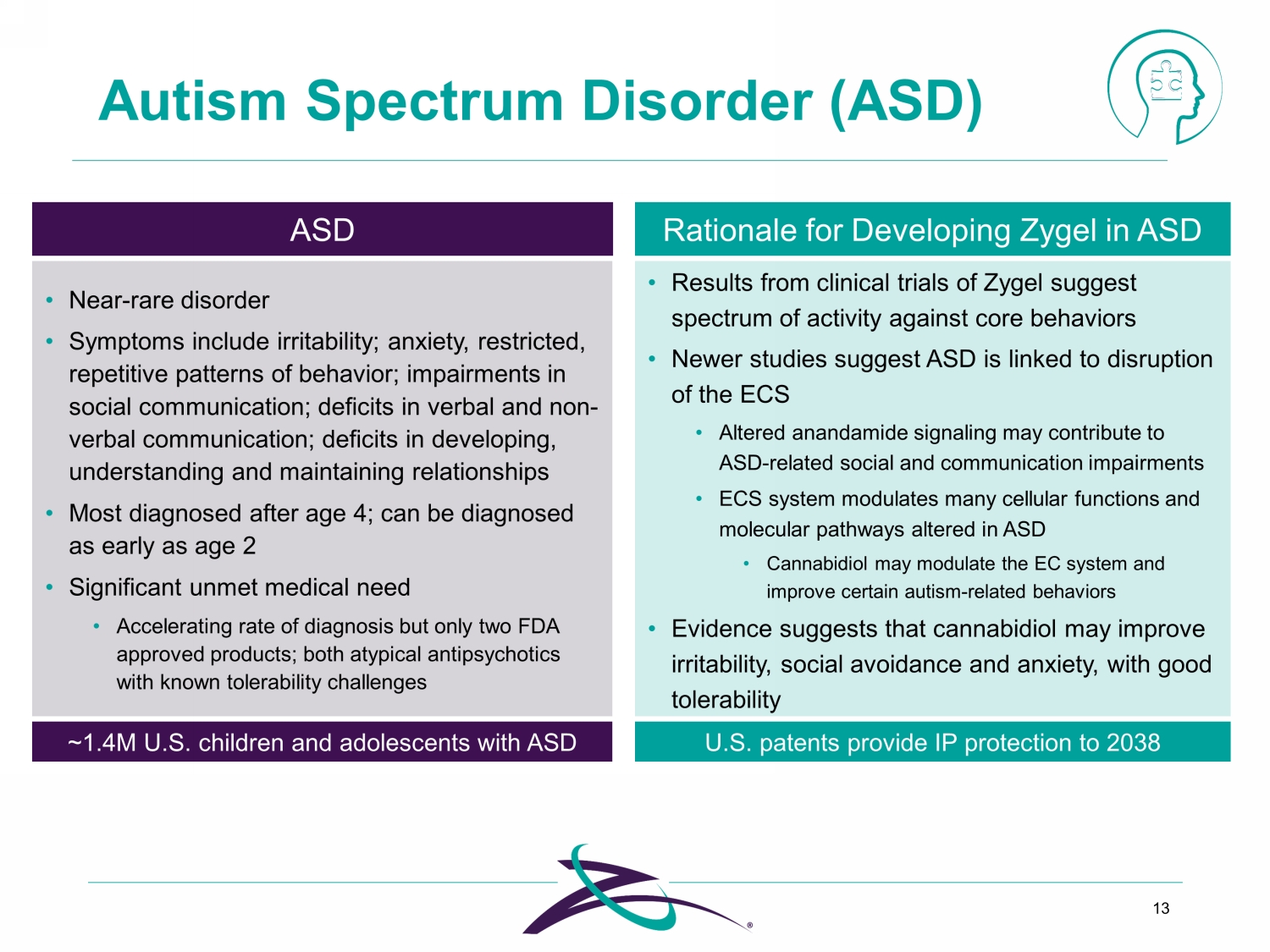
13 • Near - rare disorder • Symptoms include irritability; anxiety, restricted, repetitive patterns of behavior; impairments in social communication; deficits in verbal and non - verbal communication; deficits in developing, understanding and maintaining relationships • Most diagnosed after age 4; can be diagnosed as early as age 2 ௗ • Significant unmet medical need • Accelerating rate of diagnosis but only two FDA approved products; both atypical antipsychotics with known tolerability challenges • Results from clinical trials of Zygel suggest spectrum of activity against core behaviors • Newer studies suggest ASD is linked to disruption of the ECS • Altered anandamide signaling may contribute to ASD - related social and communication impairments • ECS system modulates many cellular functions and molecular pathways altered in ASD • Cannabidiol may modulate the EC system and improve certain autism - related behaviors • Evidence suggests that cannabidiol may improve irritability, social avoidance and anxiety, with good tolerability Autism Spectrum Disorder (ASD) Rationale for Developing Zygel in ASD ASD U.S. patents provide IP protection to 2038 ~1.4M U.S. children and adolescents with ASD

BRIGHT Phase 2 Trial in ASD 14 Open - La B el Tole R ab I lity and Efficacy Study of ZYN002 Administered as a Transdermal G el to C H ildren and Adolescen T s with Autism Spectrum Disorder 37 pts with moderate - to - severe ASD enrolled Three through 17 years of age Screening Zygel 14 Weeks Weight based dosing: 14 weeks: COMPLETE 250 mg to 500 mg daily • Aberrant Behavior Checklist (ABC - C) • Parent Rated Anxiety Scale – Autism Spectrum Disorder (PRAS - ASD) • Autism Parenting Stress Index • Autism Impact Measure (AIM) 24 Weeks Open label extension • Clinical Global Impression – Improvement (CGI - I) and Severity (CGI - S) • Qualitative Caregiver Reported Behavioral Problems Survey Efficacy assessments (primary efficacy assessment = week 14 vs baseline)

15 15 Results of BRIGHT Phase 2 Trial Autism symptom frequency and impact Parental stress Qualitative caregiver assessments Severity of anxiety Primary efficacy objective ABC - C subscales % improvement Irritability: 39.1% ( p <0.0001*) Inappropriate Speech: 42.5% ( p =0.0002*) Stereotypy: 39.1% ( p <0.0001*) Social Withdrawal: 36.4% ( p <0.0001*) Hyperactivity: 35.6% ( p <0.0001*) Qualitative Caregiver Behavioral Problems Survey % Improvements Behavioral: 69% improved Social: 63% improved Emotional: 72% improved Autism Parenting Stress Index Mean improvement of 38.9% ( p<0.0001 *) Parent Rated Anxiety Scale for ASD (PRAS - ASD) Mean improvement of 46% ( p <0.0001*) * Statistically significant Autism Impact Measure (AIM) % improvement Atypical behavior: 34.1% ( p <0.001*) Communication: 19.7% ( p <0.001*) Peer interaction: 19.8% ( p <0.001*) Repetitive behavior: 32.1% ( p <0.0001*) Social reciprocity: 10.7% ( p =0.0053*) Statistically Significant Results at Week 14 Compared to Baseline Full data available in May 26, 2020 and October 15, 2020 press releases
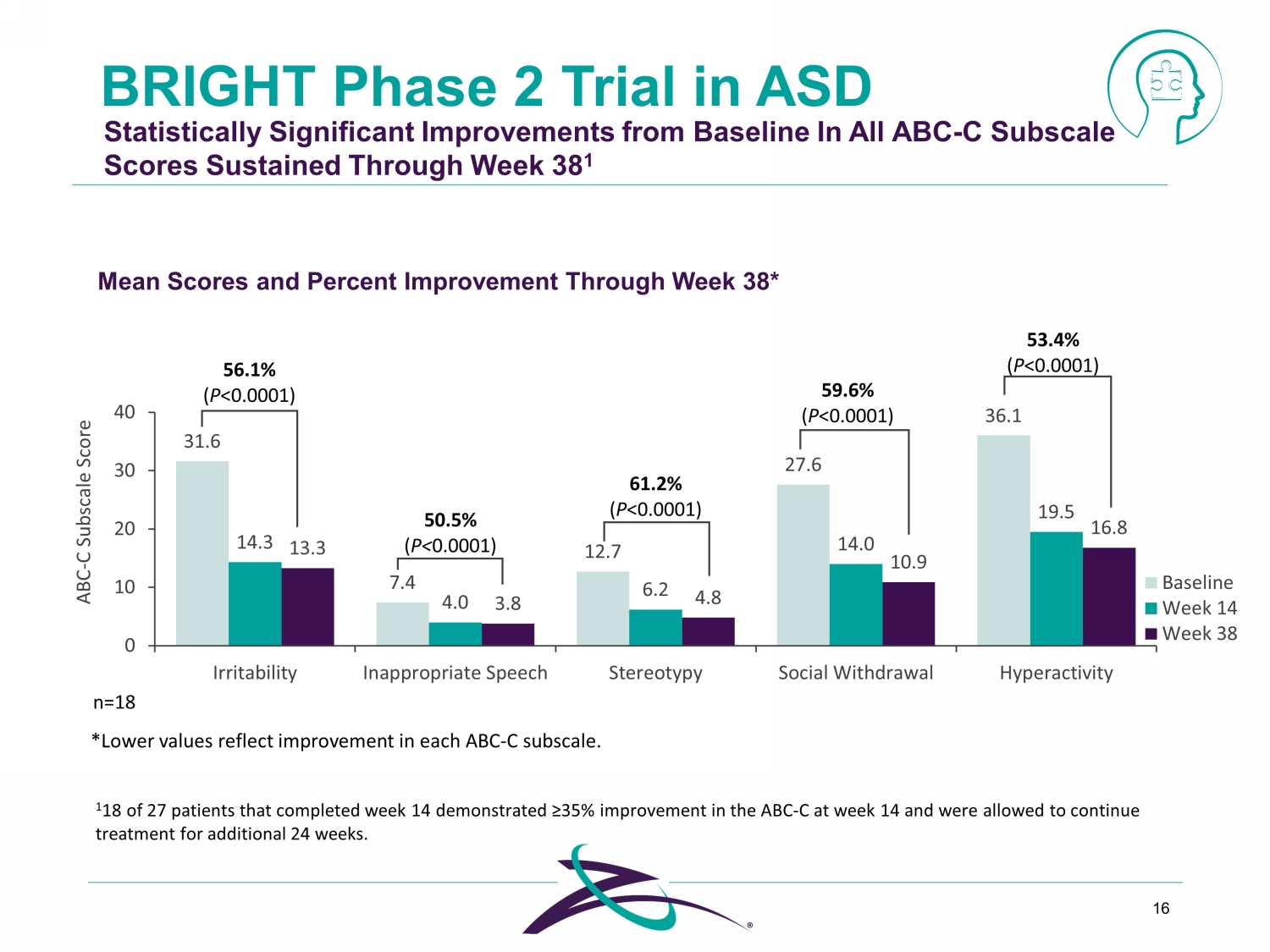
16 *Lower values reflect improvement in each ABC - C subscale. Mean Scores and Percent Improvement Through Week 38* 31.6 7.4 12.7 27.6 36.1 14.3 4.0 6.2 14.0 19.5 13.3 3.8 4.8 10.9 16.8 0 10 20 30 40 Irritability Inappropriate Speech Stereotypy Social Withdrawal Hyperactivity Baseline Week 14 Week 38 ABC - C Subscale Score 61.2% ( P <0.0001) 59.6% ( P <0.0001) 53.4% ( P <0.0001) 56.1% ( P <0.0001) 50.5% ( P< 0.0001) n=18 BRIGHT Phase 2 Trial in ASD Statistically Significant Improvements from Baseline In All ABC - C Subscale Scores Sustained Through Week 38 1 1 18 of 27 patients that completed week 14 demonstrated ≥35% improvement in the ABC - C at week 14 and were allowed to continue treatment for additional 24 weeks.

• Well tolerated and consistent with previously released data at week 14 and week 38, compared to baseline • Approximately half the patients experienced a treatment - emergent adverse event (TEAE; any event, whether unrelated or related to study drug): 49% through week 14 and 54% at week 38 • Most were mild and transient • Only 14% and 19% of patients experienced a treatment - related AE at week 14 and week 38, respectively • All application site - related at week 14 • Most application site - related and 1 each of sleep disorder, increased appetite and frequent urination at week 38 • No severe or serious AEs reported during the 38 - week trial 17 Well Tolerated Safety Profile in BRIGHT Trial in ASD
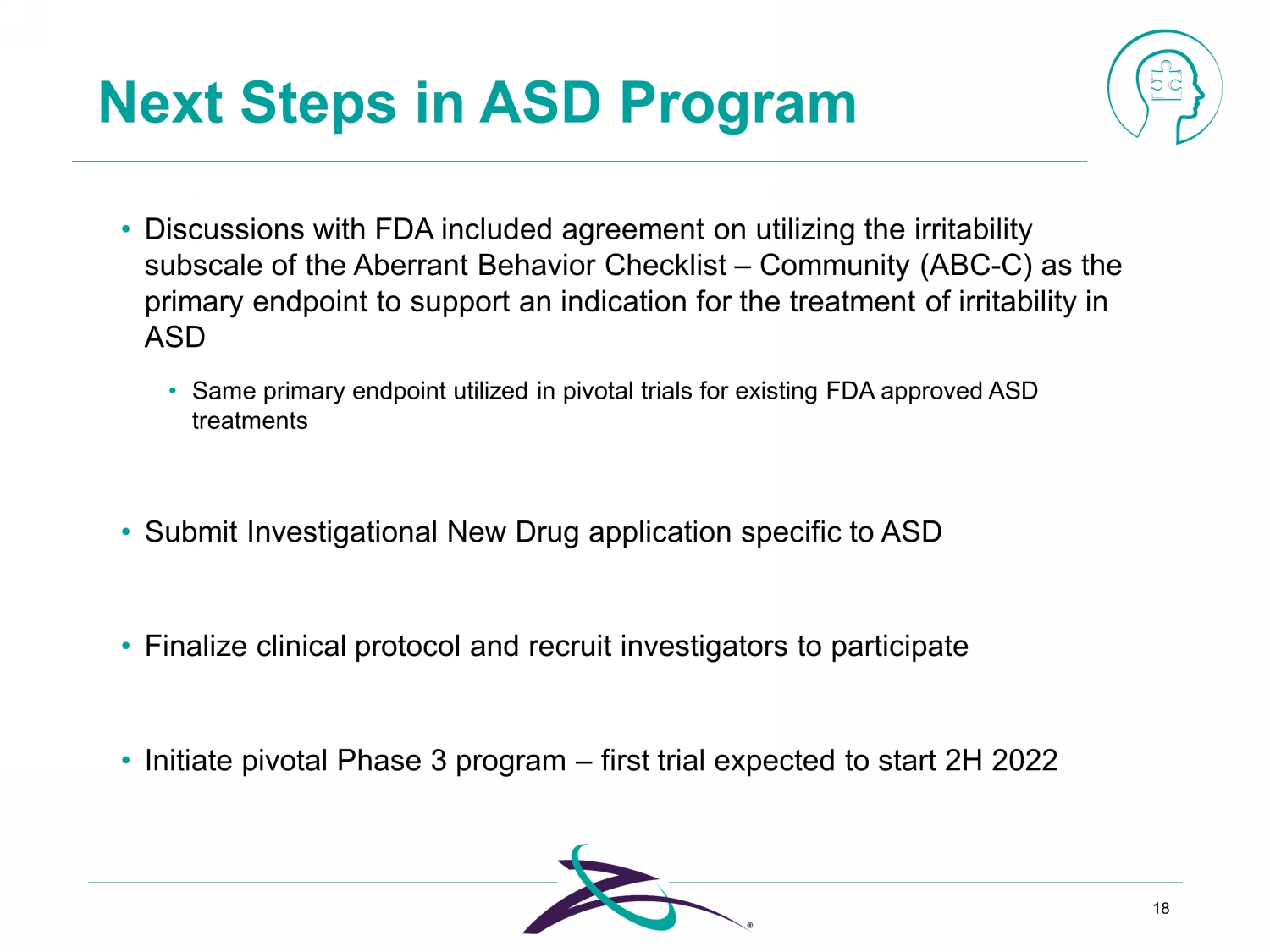
Next Steps in ASD Program 18 • Discussions with FDA included agreement on utilizing the irritability subscale of the Aberrant Behavior Checklist – Community (ABC - C) as the primary endpoint to support an indication for the treatment of irritability in ASD • Same primary endpoint utilized in pivotal trials for existing FDA approved ASD treatments • Submit Investigational New Drug application specific to ASD • Finalize clinical protocol and recruit investigators to participate • Initiate pivotal Phase 3 program – first trial expected to start 2H 2022

19 • Rare disorder; most common contiguous gene deletion syndrome • Midline condition with abnormalities affecting palate, face, heart and other organs; surgically corrected in infancy • Neuropsychiatric illnesses (anxiety disorders, ASD) and learning disabilities common • 22q associated with increased anxiety, withdrawn behavior and social interaction problems • Early onset of neuropsychiatric symptoms disrupts development and quality of life, and heightens risk of later psychotic disorders • 25 - fold increased risk of developing schizophrenia • No drugs currently approved to treat 22q • Overlapping target symptoms in FXS and ASD have been shown to respond to Zygel in trials to date • Cannabidiol may treat neuropsychiatric symptoms due to activity as: • Modulator of endocannabinoid system • Agonist at serotonin 1A receptors • Antagonist at GPR55 receptors • Enrollment complete in Phase 2 INSPIRE trial in pediatric and adolescent patients with 22q • Two sites in Australia and one site in U.S. participating 22q11.2 Deletion Syndrome (22q) Rationale for Developing Zygel in 22q 22q U.S. Orphan Drug designation for treatment of 22q ~83K U.S. patients with 22q

INSPIRE Phase 2 Trial in 22q 20 20 patients Four through 15 years of age Screening Zygel 14 Weeks Weight based dosing: 14 Weeks 250 mg to 500 mg daily Efficacy assessments (week 14 vs baseline) include: • Aberrant Behavior Checklist - Community (ABC - C) • Anxiety, Depression and Mood Scale (ADAMS) • Qualitative Caregiver Reported Behavioral Problem Survey • Clinical Global Impression – Severity and Improvement Assessing the I mpact of Zygel (Tra ns dermal Cannabidiol Gel) on P ediatr i c Behavio r al and E motional Symptoms of 22q11.2 Deletion Syndrome 24 Weeks Open label extension
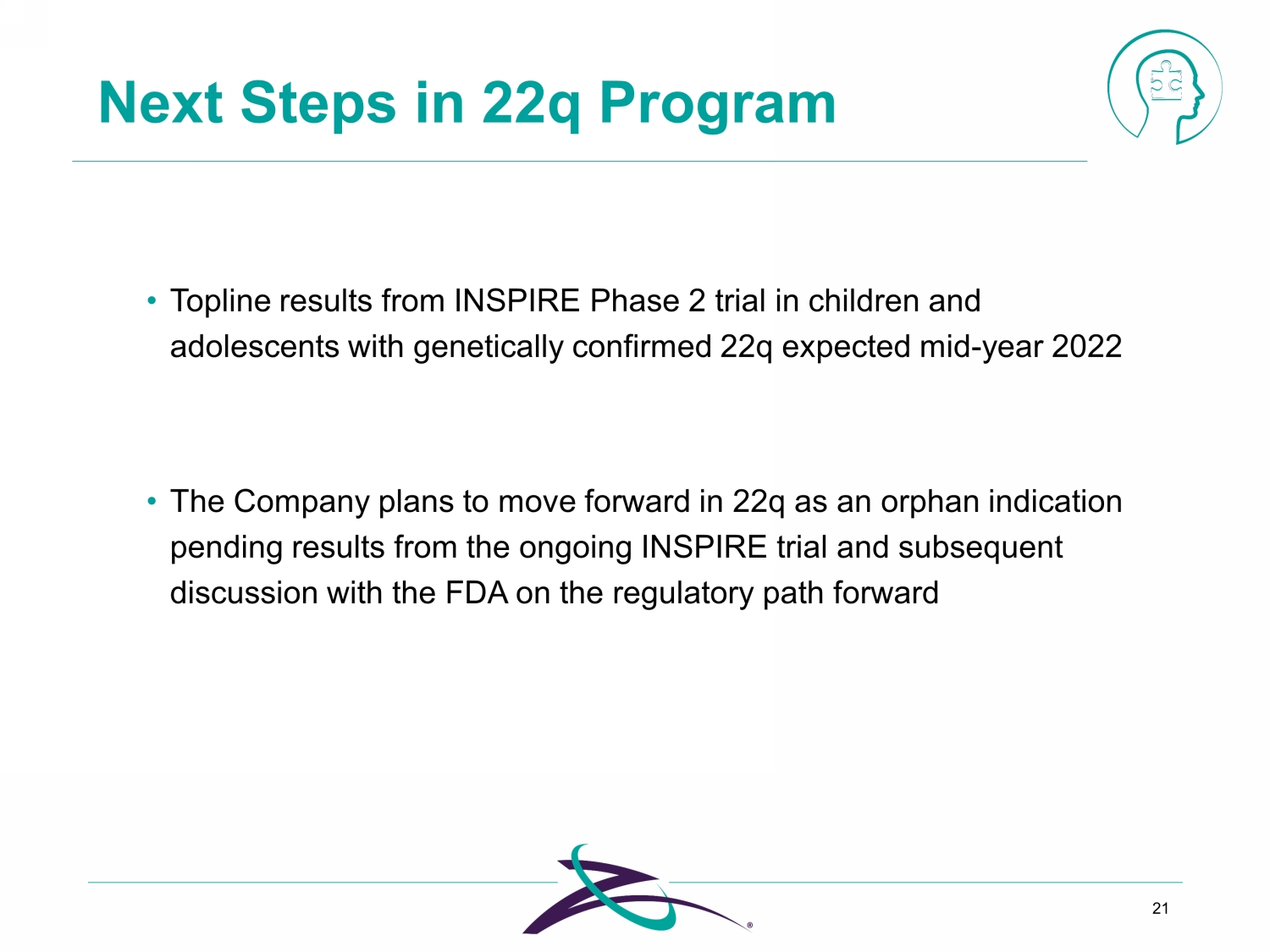
Next Steps in 22q Program 21 • Topline results from INSPIRE Phase 2 trial in children and adolescents with genetically confirmed 22q expected mid - year 2022 • The Company plans to move forward in 22q as an orphan indication pending results from the ongoing INSPIRE trial and subsequent discussion with the FDA on the regulatory path forward
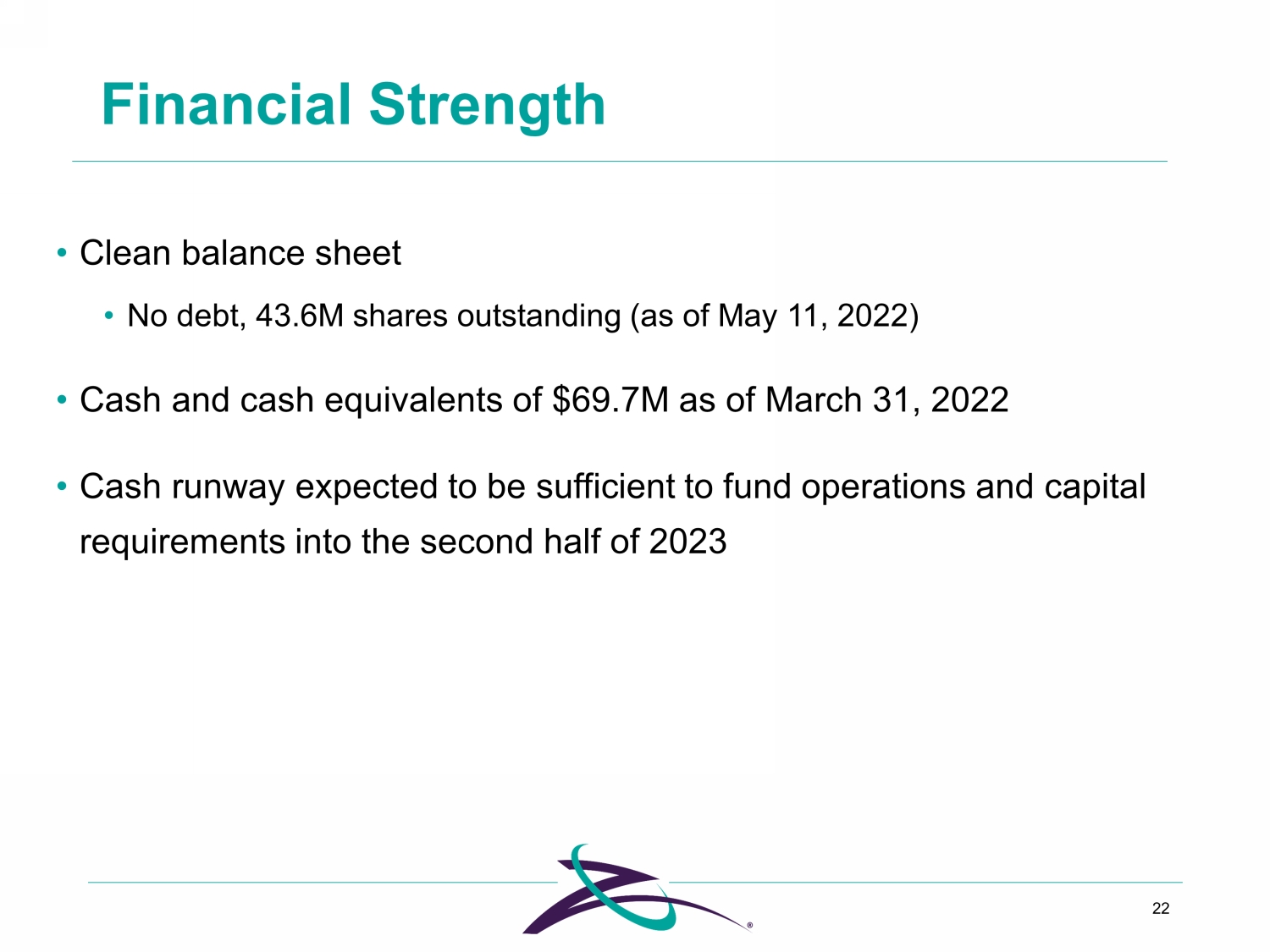
Financial Strength 22 • Clean balance sheet • No debt, 43.6M shares outstanding (as of May 11, 2022) • Cash and cash equivalents of $69.7M as of March 31, 2022 • Cash runway expected to be sufficient to fund operations and capital requirements into the second half of 2023

Deep Clinical Pipeline & Near - term Milestones 23 Zygel Cannabidiol Gel *U.S. Orphan Drug and Fast Track designations; EU Orphan Drug designation **U.S. Orphan Drug designation Expected Milestones Topline results expected 2H 2023 Initiate Phase 3 program 2H 2022 Topline results expected mid - year 2022 Indication Preclinical Phase 1 Phase 2 Fragile X Syndrome (FXS)* Pivotal BRIGHT: Topline data released Autism Spectrum Disorder (ASD) INSPIRE: Enrollment complete RECONNECT: Pivotal confirmatory trial initiated 22q Deletion Syndrome (22q)**

Corporate Overview May 2022
Serious News for Serious Traders! Try StreetInsider.com Premium Free!
You May Also Be Interested In
- Sysco Declares Increase to Quarterly Dividend
- Epsilon Energy Ltd. Schedules First Quarter 2024 Earnings Release and Conference Call
- First Commerce Bancorp, Inc. Reports the First Quarter 2024 Results and Declares a Quarterly Cash Dividend of $0.04 per Common Share
Create E-mail Alert Related Categories
SEC FilingsSign up for StreetInsider Free!
Receive full access to all new and archived articles, unlimited portfolio tracking, e-mail alerts, custom newswires and RSS feeds - and more!



 Tweet
Tweet Share
Share